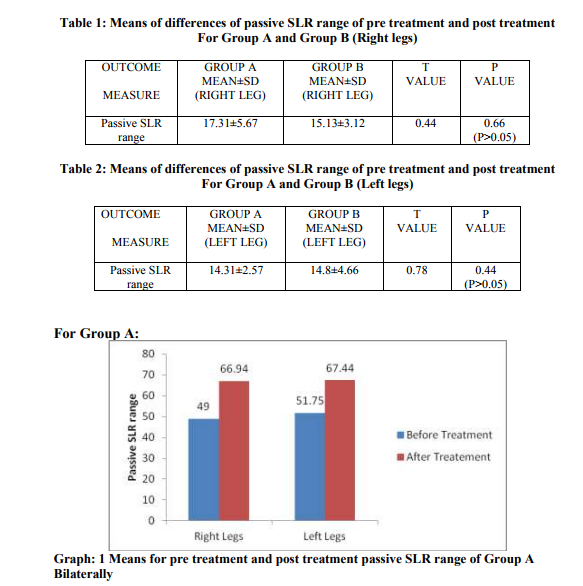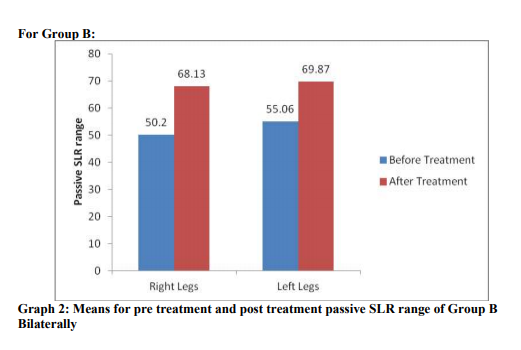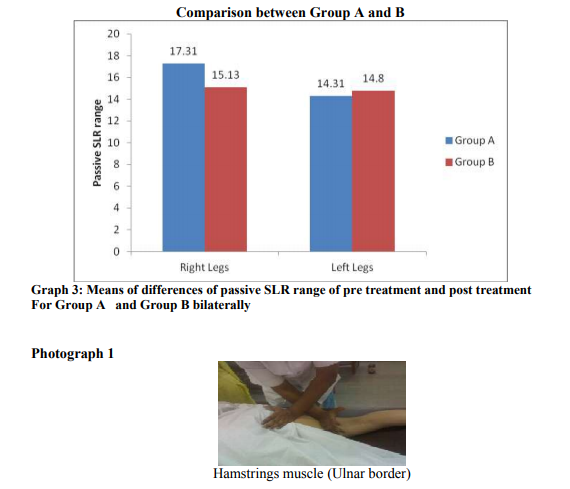IJCRR - 4(6), March, 2012
Pages: 43-48
Print Article
Download XML Download PDF
EFFECT OF MYOFASCIAL RELEASE ON HAMSTRINGS TIGHTNESS IN HEALTHY INDIVIDUALS
Author: Salvi Shah
Category: Healthcare
Abstract:Introduction: To date, there are very few reports comparing on duration of hold of end position in MFR on joint range of motion (ROM) and hamstring muscle tightness. The purpose of this study was to examine the length of time the hamstring muscles should be placed in end position of MFR. Aim of Study: To study the effect of myofascial release (MFR) in reducing the hamstrings tightness. Methodology: Study design: An experimental comparative study Sample selection: A random sample of 31 students were taken from SBB Physiotherapy college, Ahmedabad after giving due consideration to inclusion and exclusion criteria. All of them took part in study on a voluntary basis after signing consent. Sample size: Total 31.In Group A: 16 students (End position of MFR was maintained for 30 seconds) Group B: 15
students (End position of MFR maintained for 60 seconds) Inclusion criteria Normal healthy individuals, female students, age group: 16-24 years, hamstrings are tight and passive straight leg raising (SLR) range was between 30-70 ranges. Exclusion criteria Any fracture of spine or lower limb within last 6 months, tight rectus femoris and tight ilio psoas, hypersensitive to skin Outcome measure Passive Straight leg raising (SLR) test. MFR was given for total of 12 sessions with subject in prone position for 5 repetitions/session 6 days in a week for 2 weeks to both groups. Results: In Group A and Group B results showed highly significant improvement in passive SLR after 10 days of treatment at 5% level of significance. On comparing Group A and Group B the results showed no significant difference in passive SLR between both groups at 5% level of significance. Conclusion: From the present study it can be concluded that, by
MFR there was significant improvement in passive SLR range. But no significant difference in improvement of passive SLR if we hold the end position for 30 seconds or 60 seconds.
Keywords: MFR, tightness, hamstrings
Full Text:
INTRODUCTION
Flexibility is an essential component of injury prevention and rehabilitation 1 . Several modalities or physical agents have been used in conjunction with stretching to enhance further increases in range of motion. One study found that the application of ice increased short term improvement of hamstring flexibility over stretching alone2 .Research has shown hamstring flexibility can significantly increase when prolonged stretching is used in combination with shortwave diathermy3 . People encounter various kinds of muscle tightness and always keep trying to get off from it. There are number of ways to get cured and say good bye to tightness. Myofascial release (MFR) is a “curative” tool for treatment of the tightness.
Myofascial release is a collection of techniques used for the purpose of relieving soft tissue from an abnormal hold of a tight fascia 4 .Direct bodily effects range from alleviation of pain, improvement of athletic performance, and greater flexibility and ease of movement to more subjective concerns such as better posture. More indirect goals include emotional release, deep relaxation, or general feelings of connection and wellbeing. Rather than being a specific technique, MFR is better understood as a goal-oriented approach to working with tissue-based restrictions and their two-way interactions with movement and posture5 . But suddenly some “questions” appears which are “cloudy” in mind and bring same form of confusion with them. - For how many times in a day we have to apply MFR? - For how long is it effective? - For how long we have to hold end position? - Does person require any other type of stretching or flexibility exercises along with MFR for tightness? The main aim of doing this study was as follows: - To study effectiveness of MFR on hamstring muscle tightness. - To study the comparative effectiveness of two different duration hold of end position of MFR between groups. So the objective of this study was to determine if the use of MFR would decrease the tightness of hamstring muscle group determined by a Passive SLR test.
MATERIALS AND METHODOLOGY
Study design: An experimental comparative study Study setting: SBB Physiotherapy College, V.S. hospital, Ahmedabad Sample selection A random sample of 31 students were taken from SBB Physiotherapy college, V.S. hospital, Ahmedabad after giving due consideration to inclusion /exclusion criteria. All of them took part in study on voluntary basis after signing consent. Sample size 31 Group A: 16 students (End position of MFR maintained for 30 seconds) Group B: 15 students (End position of MFR maintained for 60 seconds) Selection criteria: Inclusion criteria Normal healthy individuals, female students, age group: 16- 24 years, hamstrings are tight and passive straight leg raising (SLR) range was between 30-70 ranges. Exclusion criteria Any fracture of spine or lower limb within last 6 months, tight rectus femoris and tight ilio psoas, hypersensitive to skin Outcome measure Passive Straight leg (SLR) raising test Passive SLR test is extensively used as an outcome measure6-9 to measure hamstring muscle tightness.
Procedure
Subjects who fulfilled all inclusion criteria were taken up for study. The procedure was explained to all subjects. All subjects signed consent and were allocated randomly to either group A or Group B. The intervention covered total 12 training sessions, at a frequency of 6 sessions per week and 5 repetitions in each session. The Passive Straight leg raising test (SLR) was used as criterion measurements. Goniometer was to measure angle between straight leg and table. Before the start of study and again after 2 weeks of treatment, Passive Straight leg raising (SLR) test was done. Subjects were divided into 2 groups. Group A (n=16) in which end position of MFR was maintained for 30 seconds and in Group B (n=15) in which end position of MFR was maintained for 60 seconds. MFR was given with subjects in prone position for both groups. With the use of ulnar border of hand MFR was given from proximal to distal direction using a light amount of pressure over hamstring muscle. The therapist had scaled the pressure following contact until the slack in the skin was taken up and that position was held until the tissues begins to soften. Like that hand was moved slightly as the tissue opened. The hand position was crossed in order to work as energy efficiently as possible. (Photograph 1) In Group A end position was maintained for 30 seconds and for the Group B maintained for 60 seconds. The subjects were observed for any change skin colour and asked to report if there was any discomfort during the treatment sessions. All the subjects had completed the whole treatment program of 2 weeks without any discomfort. All the subjects were instructed not to do any flexibility or stretching exercises for the lower limbs during treatment program.
RESULTS
For this study 31 people were randomly selected based on inclusion and exclusion criteria. From that 16 people were included in Group A and rests were included in Group B. In Group A end position of MFR was maintained for 30 seconds and for the Group B maintained for 60 seconds. The intervention covered total 12 training sessions, at a frequency of 6 sessions/week and 5 repetitions in each session. All the statistical analysis was done with the help of Graph Pad Demo version. Student‘s t-test (paired t-test) was applied for within group comparison of Group A and Group B for both legs. In the Group A and Group B results showed highly statistically significant improvement in passive SLR range after 12 training sessions at 5% level of significance. (Graph 1, Graph 2) Comparison between Group A and Group B Student‘s t test (unpaired t test) was applied between group comparison for Group A and Group B for both legs. On comparing group A and group B the results showed no statistically significant difference in improvements in passive SLR range at 5% level of significance. (Graph 3, Table 1 and Table 2)
DISCUSSION
The present study was conducted to see the effect of MFR on hamstring muscle tightness on healthy individuals. The results showed that, both the treatment groups showed significant improvement in passive SLR range after intervention. But results for between group analysis (Group A: End position of MFR was maintained for 30 seconds, Group B: End position of MFR maintained for 60 seconds) showed that no statistically significant difference in improvements in passive SLR range at 5% level of significance. The probable reason for this result was that MFR technique mainly involves the golgi tendon organ. The pressure associated with myofascial release causes the golgi tendon organ to sense a change of tension in the muscle and responds to this high or prolonged tension by inducing relaxation of the muscle spindles 10 . So, there was improvement in hamstring muscle tightness in both the groups with MFR. The reason for between groups results was that 30 seconds hold of end position of MFR was sufficient to stimulate golgi tendon organ, hence induce relaxation of muscle spindles. So there was a decrease in tightness of hamstring muscle and no need to hold end position of MFR for 60 seconds unnecessarily.
CONCLUSION
It can be concluded from the present study that, both groups showed highly statistically significant increase in ROM of hamstring muscles bilaterally based upon their passive SLR test; But when comparing two groups, there was no statistically significant difference in improvement of ROM of hamstring muscles bilaterally based upon their passive SLR test if we hold the end position for 30 seconds or 60 seconds. So MFR can be used to reduce tightness of hamstring muscles but no need to hold end position more than 30 seconds unnecessarily. Enhanced understanding of the effect of end position of MFR on the hamstring muscles as a result of the findings of our study will hopefully enable clinicians to provide more effective and scientifically based treatment when incorporating MFR into rehabilitation programs.
Short Comings
Study could have done on more number of people. Effect of MFR was not so long lasting. Along with MFR it was really required to do stretching and flexibility exercises for the maintenance of gained range in muscles.
ACKNOWLEDGEMENT
I would like to thank my all the staff members of SBB Physiotherapy College, Ahmedabad for their expert guidance and continuous encouragement with their keen interest in my work. I would like to thank all my friends and colleagues who helped me throughout the time of completing the study. Author acknowledges the immense help received from the scholars whose articles are cited and included in references of this manuscript. The author is also grateful to authors / editors / publishers of all those articles, journals and books from where the literature for this article has been reviewed and discussed.
References:
1. Corbin. CB, Noble L. Flexibility: a major component of physical fitness. J Phys Educ Recreat Dance. 1980; 51:57-60
2. Brodowicz GR, Welsh R, Wallis J. Comparison of stretching with ice, stretching with heat, or stretching alone on hamstring flexibility. J Athl Train. 1996; 31(4):324-327.
3. Draper DO, Castro JL, Feland B, Schulthies S, Eggett D. Shortwave diathermy and prolonged stretching increase hamstring flexibility more than prolonged stretching alone. J Orthop Sports Phys Ther. 2004; 34(1):13-20.
4. Prentice WE. Arnheim‘s Principles of Athletic Training. Madison, WI: McGraw-Hill; 2003:85-90.3.
5. Myofascial Release Keith Eric Grant and Art Riggs
6. Tanigawa MC: Comparison of the hold-relax procedure and passive mobilization on increasing muscle length. Phys Ther 52:725-735, 1972
7. Medeiros JM, Smidt GL, Burmeister LF, et al: The influence of isometric exercise and passive stretch on hip joint motion. Phys Ther 57:518-523, 1977
8. Moore MA, Hutton RS: Electromyographic investigation of muscle stretching techniques. Med Sci Sports 12:322-329,1980
9. Halkovich LR, Personius WJ, Clamann HP, et al: Effect of Flouri-Methane® spray on passive hip flexion. Phys Ther 61:185-189, 1981
10. Jacklyn K. Miller, Ashley M. Rockey Foam Rollers Show No Increase in the Flexibility of the Hamstring Muscle Group UW-L Journal of Undergraduate Research :IX ,2006



|






 This work is licensed under a Creative Commons Attribution-NonCommercial 4.0 International License
This work is licensed under a Creative Commons Attribution-NonCommercial 4.0 International License